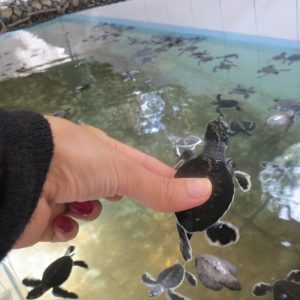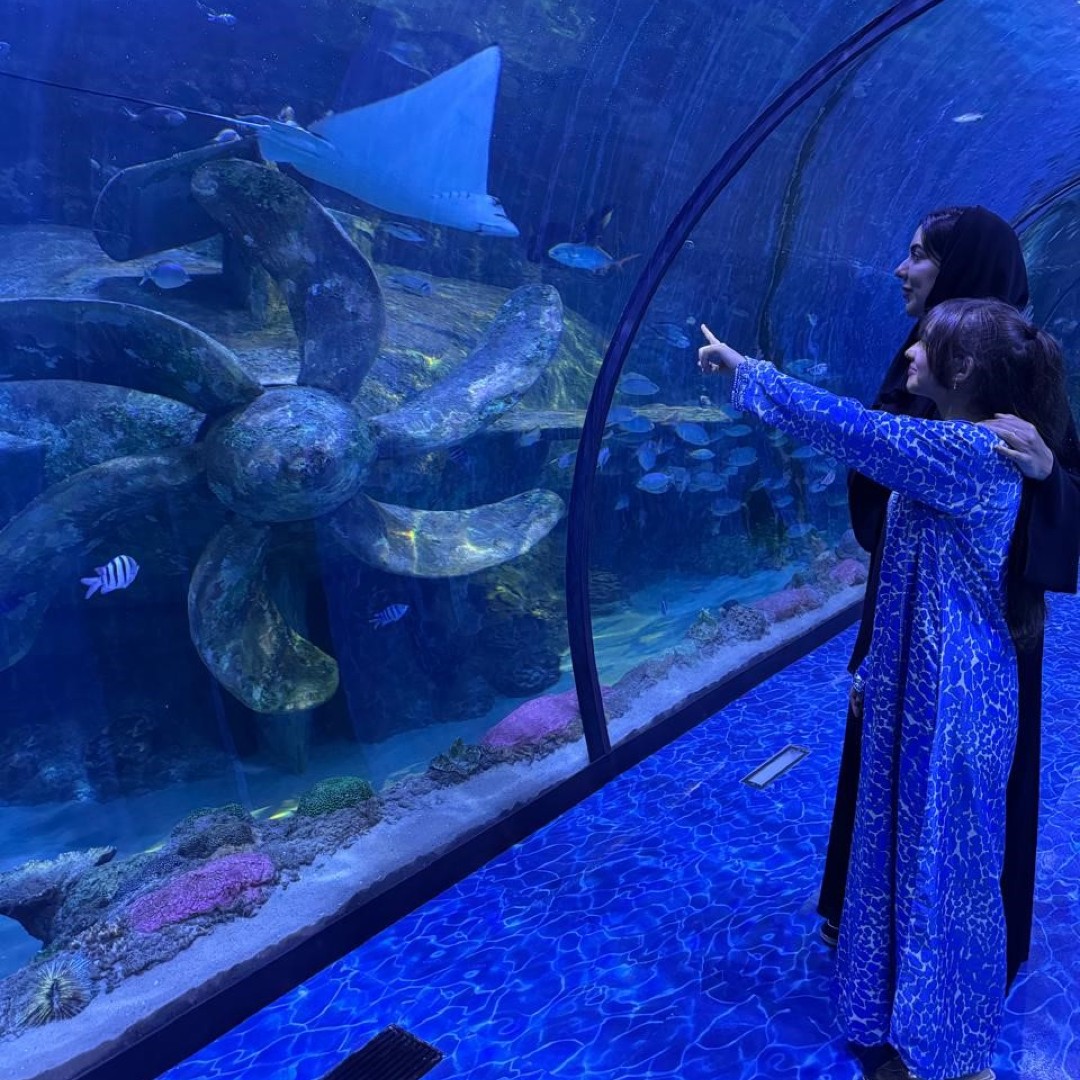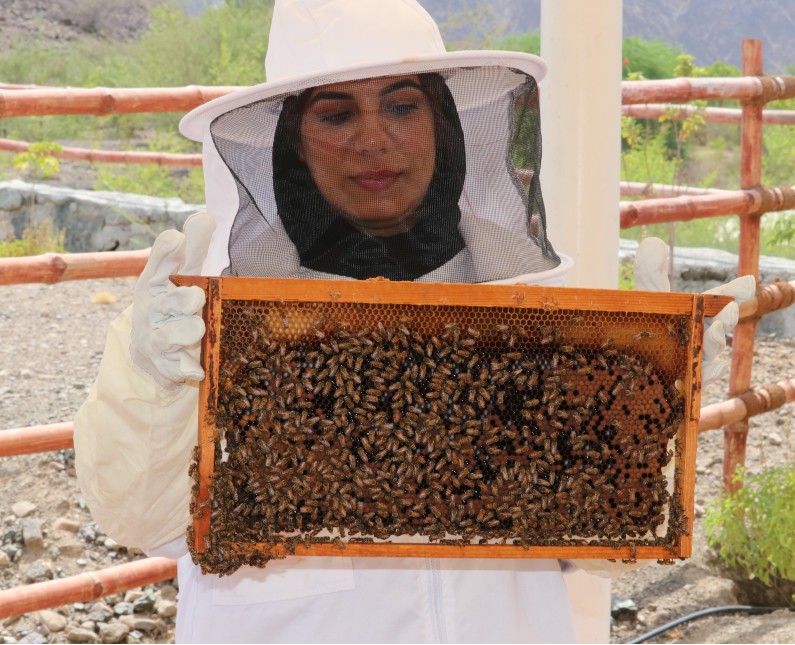Today is a family affair, which perfectly encapsulates the Fund’s philosophy. Meet 13-year-old Mahra Al Mazrouei, a close relative of Salima Raai, the first employee of the Mohamed bin Zayed Species Conservation Fund. Mahra has a passion for animals, a curious mind, and a deep admiration for her favorite aunt and the vital work she has been doing to protect animals worldwide. In her eyes, Salima wears a superhero cape to work. Let’s find out more about her thoughts, inspirations and goals as she interviews Aunty Salima.
Mahra Al Mazrouei (MA): I know you as Aunty Salima, but not everyone else is lucky enough to know you like I do. Could you share who you are and what amazing work you do?
Salima Raai (SR): My name is Salima Mohamed Raai, a Moroccan who was born in a place called Dar Al Salam in an area filled with gardens, valleys and birds, I was very young, and my father was a photographer for Moroccan television at that time and he was taking me with him to shoots documenting about nature. After that I spent my childhood between Morocco and the UAE, two places that shaped my love for nature and my sense of purpose. Each summer, I returned to Morocco and spend time on our family farm, surrounded by the natural beauty that first sparked my commitment to conservation. It’s a reminder of why this work is so close to my heart and why protecting our planet’s species is essential for future generations
I started my journey with MBZF in the same year that the Fund was established in 2009, now after 15 years in species conservation, I’m honoured to be the first employee at the Fund, I started as a Health and Safety Officer, Grant Processing Officer, and Project Coordinator.
In these roles, I manage grants for conservationists worldwide, people whose dedication and courage to protect vulnerable species inspire me daily. My work is about ensuring these passionate individuals and projects have the support they need to protect our planet’s biodiversity.
MA: How did you become the first employee of the MBZF? Was it a dream job or a lucky opportunity?
SR: It’s a story I still smile about. When the Fund was first established, they needed someone to help set up operations and bring their vision to life on the administrative side. At that time, I had just graduated and was exploring different career paths while helping my father with his businesses. I spent a year learning about production, directing, photography, and videography—skills that remain some of my favourite pastimes today. I also supported his other business, managing administrative work and gaining hands-on experience in organizational tasks.
As the year went on, I found myself wondering if perhaps my next steps lay in Morocco. But then, just when I felt ready for a new direction, an unexpected opportunity came along—a chance to be part of the Mohamed bin Zayed Species Conservation Fund. A wonderful leader saw my potential and gave me the opportunity, inviting me to join as the Fund’s very first employee. I was beyond excited, not only to take on this role but to be part of a mission so close to my heart from the very beginning. Watching the Fund grow and seeing the impact we’ve made over the years has been nothing short of inspiring. It truly feels like I was meant to be here, helping protect our planet’s incredible biodiversity.
MA: What did you do before starting at MBZF?
SR: Before joining the Fund, I spent much of my time alongside my father, who truly inspired my love for nature. Growing up, I watched him create documentaries on mangroves, turtles, and dugongs, with many projects at the Environmental Agency under his name. He always encouraged me to get involved in environmental initiatives, often taking me along on projects that are related to species conservation. Some of my earliest and most impactful experiences were volunteering in beach cleanups, where I felt the immediate, hands-on impact of restoring our natural spaces.
A particularly unforgettable moment was visiting the Falcon Hospital in Sweihan and the National Bird Research Centre, where my father filmed Abu Dhabi’s first documentary on migratory birds in 1996. He also created two remarkable films, Zayed, the First Environmentalist and Zayed, the First Falconer, which celebrated Sheikh Zayed’s commitment to conservation and beautifully connected the UAE’s environment which he was deeply passionate about. Witnessing his dedication to showcasing and preserving biodiversity gave me a profound understanding of the importance of conservation.
In addition to these field experiences, I was often involved in organizing events and helping others, discovering a passion for work that directly impacts both people and species. Conservation has always felt like a calling, and each of these experiences helped prepare me for the journey to start at the Mohamed bin Zayed Species Conservation Fund. Joining the Fund felt like a natural step, enabling me to channel my passion for protecting species on a much broader scale.
MA: Was working with species always something you wanted to do?
SR: Absolutely—animals have always held a special place in my heart. Growing up on a farm, I was surrounded by rabbits, cows, sheep, peacocks, and so many other animals. I learned from an early age that each creature has its own unique needs and beauty, and I loved seeing how each one was cared for in its own way.
 In 2015, I took my first solo trip to Sri Lanka—a journey my father encouraged me to take on my own so I could start learning to rely on myself. There I discovered the breathtaking Peradeniya Botanical Garden home to over 4,000 plant species—a true sanctuary of life. I also visited a sea turtle farm where I saw the dedication of people working tirelessly to protect these beautiful creatures from extinction. I even had the unforgettable experience of releasing baby turtles into the ocean watching them disappear into the waves. It was a moment that touched my heart deeply and fuelled my commitment to conservation.
In 2015, I took my first solo trip to Sri Lanka—a journey my father encouraged me to take on my own so I could start learning to rely on myself. There I discovered the breathtaking Peradeniya Botanical Garden home to over 4,000 plant species—a true sanctuary of life. I also visited a sea turtle farm where I saw the dedication of people working tirelessly to protect these beautiful creatures from extinction. I even had the unforgettable experience of releasing baby turtles into the ocean watching them disappear into the waves. It was a moment that touched my heart deeply and fuelled my commitment to conservation.
Later, my first dive in Bali revealed a world beneath the surface I had only seen on TV—vibrant marine life, each species a wonder in its own right. That dive strengthened my connection to nature and made me realize that my path was meant to be in protecting these incredible forms of life. I didn’t know exactly how at the time, but entering the field of conservation felt like finding my true purpose.
MA: What are species? I thought MBZF only focused on animals.
SR: That’s such an important question, and it’s one I’m always excited to answer! After spending 15 years in conservation, I’ve come to see that understanding what a “species” truly means is essential to grasping the depth of our mission.
A species is a group of living organisms that share common traits and can reproduce together. But here’s what often surprises people: species are not just animals. They encompass an incredible variety of life forms—plants, insects, fungi, fish, even the microorganisms we can’t see with the naked eye. Each one, no matter how small, plays a unique and critical role in its ecosystem. From supporting soil health to maintaining water quality and contributing to the food chain, every species contributes to the balance of life in ways we’re still discovering.
At the Mohamed bin Zayed Species Conservation Fund, our commitment extends beyond the more visible species, like large mammals or iconic birds. We also support projects that protect the lesser known, sometimes overlooked species, like specific plants or tiny insects that are fundamental to healthy ecosystems. By preserving them all, we’re safeguarding the diversity of life on our planet and creating a healthier, more resilient world for generations to come.
Each species adds a thread to the intricate tapestry of nature, and together, they weave the story of our planet’s rich biodiversity. Protecting them isn’t just our work—it’s our way of honouring and sustaining life itself.
MA: What does your daily work involve? What do you do most days?
SR: Every day is different, and that’s part of what I love about this work. Generally, I spend a lot of my time managing grant projects—processing payments, addressing inquiries, and making sure everything runs smoothly. I work closely with different teams on a variety of tasks to keep projects on track, and each day often includes meetings with different conservation partners from around the world. In these discussions, we explore field challenges, brainstorm solutions they’ve developed in remote areas, and tackle the unique obstacles they face.
It’s a mix of responsibilities, from administrative work to collaborative problem-solving, but each task feels meaningful. Even the behind-the-scenes details are essential, knowing they contribute to supporting conservation efforts worldwide. It’s incredibly rewarding to be part of something that’s making a tangible impact on our planet, helping to protect species and preserve ecosystems for future generations.
MA: With all the people you meet and projects you see, which ones stand out the most?
SR: That’s a tough question because there are so many inspiring projects. But one that stands out is the dugong and seagrass project, which I had the privilege to work on. I like to call dugongs the “Gentle Sea Guardians” because of their serene presence and the essential role they play in maintaining the health of seagrass beds. These lush underwater meadows are not only the dugongs’ lifeline but also critical to the overall health of our oceans.
This project isn’t just about protecting a single species; it’s about preserving a whole ecosystem that supports a wide range of marine life. Working on this project was a constant reminder of the incredible interconnectedness of life beneath the waves. It’s projects like these that reinforce the importance of conservation and inspire me to continue supporting efforts that protect both species and their habitats.
MA: What does seagrass mean, Aunty? And why is it important for this beautiful marine animal?
SR: Great question! Seagrass is a green, underwater plant that plays a crucial role in the health of our oceans. It forms vast beds on the ocean floor, creating a safe haven where dugongs can feed, rest, and thrive. Seagrass supports many marine species, providing shelter and food not only for dugongs but for countless other creatures as well.
What makes seagrass truly special is that it doesn’t just support marine life; it also improves water quality and acts as a natural carbon store, helping to combat climate change. By trapping carbon in its roots and leaves, seagrass beds reduce the amount of CO2 in the atmosphere, contributing to a healthier planet overall.
Working on this project, I had the chance to witness people from all around the world come together to protect this vital mammal. They dedicated their time and energy to raise awareness in their communities and work side-by-side to reduce the risk of extinction for dugongs, especially in areas where human-wildlife conflict is a real threat. It’s inspiring to see so many people united for such an important cause, striving to protect a species and ecosystem that touch so many aspects of our environment.
MA: If you could save just one species forever, which one would it be and why?
SR: That’s a very tough choice, as each species plays a unique role on our planet. But if I had to choose just one, it would be bees. Bees are incredible creatures with both cultural and environmental importance. As pollinators, they’re essential for many of the crops and plants we rely on for food, air quality, and ecological balance. Without bees, our supply of foods like apples, berries, avocados, coffee, and onions would drop significantly, impacting our diets and ecosystems alike.
Beyond their ecological role, bees hold special significance in our cultural heritage and faith. In the Holy Qur’an, there’s an entire Surah named after bees, which beautifully illustrates their importance: “Then eat from all the fruits and follow the ways of your Lord laid down [for you].” There emerges from their bellies a drink, varying in colours, in which there is healing for people. Indeed, in that is a sign for a people who give thought.”
They may be small, but bees are truly powerful. By supporting their survival, we help sustain countless other species, including ourselves. Protecting bees is about nurturing an entire web of life and preserving the balance that we and future generations rely upon.
As Muslims, we find in the Qur’an, our sacred guide, a profound appreciation for nature and a clear call to protect it. The Qur’an beautifully reminds us of our role as caretakers of the Earth, emphasizing the harmony and balance we are meant to uphold among all living things—people, animals, plants, and beyond. This responsibility to protect and nurture nature is woven deeply into our faith, and it inspires my work every day in species conservation. It’s a reminder that our actions should reflect respect and care for the world we’ve been entrusted to preserve.
MA: What is the coolest part of your work?
SR: The coolest part of my work is knowing that what we do truly makes a difference for people and wildlife across the globe. Every day, I get to learn about remarkable conservation projects happening worldwide and witness the direct impact they have. I connect with passionate people who are working to save endangered species and protect unique habitats, often in incredibly challenging conditions. Hearing their stories and seeing their dedication firsthand is deeply inspiring.
It’s a reminder that every single effort counts, and together, we’re contributing to a brighter future for our planet. Being part of something bigger, something that protects nature for generations to come, is truly fulfilling.
MA: How can I grow up to be like you? What advice would you give me?
SR: You already have a wonderful start! I see your curiosity and your love for animals in the way you care for your cat. Keep that curiosity alive, and don’t be afraid to ask questions and explore your passions. Try getting involved in conservation activities at school or in your community, whether it’s a beach cleanup, a local wildlife project, or volunteering with an environmental organization. Each small step adds up, and hands-on experience teaches you so much.
Most importantly, always stay curious and keep learning—just like you are now. That spark of curiosity will lead you to places you can’t even imagine yet!
MA: What do you think conservation will look like 10 years from now?
SR: In 10 years, I believe conservation will be even more innovative and interconnected. We’ll likely see technology playing a major role—things like drones, artificial intelligence, and real-time monitoring will allow us to protect habitats and species with incredible precision. Conservation efforts will be driven by communities around the world, working together and sharing knowledge and experience, because people are beginning to understand just how much we all rely on nature.
10 years from now, you’ll be a young Emirati woman contributing to the UAE’s vision for sustainability in conservation and climate. You are in a country dedicated to protecting the planet and supporting species worldwide—a generous legacy started by Sheikh Zayed. It’s up to us to carry this forward for future generations to experience and cherish- And you should build some of these efforts in the future.



